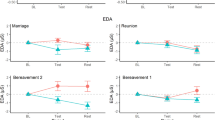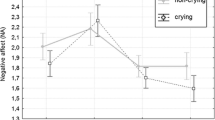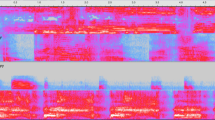Abstract
Spectral analysis was used to investigate the modification of the excessive crying (48% of waking time observed during baseline) of a terminal cancer patient. Initial assessment revealed a cyclic pattern of crying and dozing throughout the day and night. Intervention involved timeout from social stimulation contingent upon crying and differential social reinforcement for behaviors incompatible with crying. Analysis showed the gradual elimination of crying during the 15-day intervention. During the initial phase of intervention crying ceased to be emitted in the presence of hospital staff but was evoked by the presence of family members. As this pattern of crying diminished, the frequency and duration of family visits, as well as the frequency of positive patient utterances and conversation, increased. Clinical, ethical, and methodological issues surrounding the use of timeout are discussed.
Similar content being viewed by others
References
Etzel, B. C., and Gewirtz, J. L. (1967). Experimental modification of caretaker-maintained high-rate operant crying in a 6- and a 20-week-old infant: Extinction of crying with reinforcement of eye contact and smiling.J. Exp. Child Psychol. 5: 303–317.
Fordyce, W. E. (1973). An operant conditioning method for managing chronic pain.Postgrad. Med. 53: 123–134.
Fordyce, W. E. (1976a).Behavior Methods for Chronic Pain in Illness, Mosby, St. Louis.
Fordyce, W. E. (1976b). Behavioral concepts in chronic pain in illness. In Davidson, P. O. (ed.),The Behavior Management of Anxiety, Depression, and Pain, Brunner/Mazel, New York.
Gottman, J. (1980).Time-Series for Social Scientists, Cambridge University Press, New York.
Jenkins, G. M., and Watts, D. G. (1968).Spectral Analysis and Its Applications, Holden-Day, San Francisco.
Redd, W. H. (1980). Stimulus control and extinction of psychosomatic symptoms in cancer patients in protective isolation.J. Consult. Clin. Psychol. 48: 448–455.
Redd, W. H., and Birnbrauer, J. S. (1969). Adults as discriminative stimuli for different reinforcement contingencies with retarded children.J. Exp. Child Psychol. 7: 440–447.
Author information
Authors and Affiliations
Additional information
This research was completed while the author was on sabbatical leave from the University of Illinois and was supported in part by Grant CA 12582 from the National Institutes of Health and a gift from the Holmes Institute, Los Angeles, California. The author wishes to express his appreciation to Janet Kruse for her assistance in data analysis and to the following individuals for their help in conducting the research and in reporting the results: James Goodnight, Karen Nowlan, Bev Drury, Stephen Porges, Martha Putallaz, Graciela Vazquez-Andresen, and Sharon Medlock.
Rights and permissions
About this article
Cite this article
Redd, W.H. Treatment of excessive crying in a terminal cancer patient: A time-series analysis. J Behav Med 5, 225–235 (1982). https://doi.org/10.1007/BF00844811
Accepted:
Issue Date:
DOI: https://doi.org/10.1007/BF00844811




